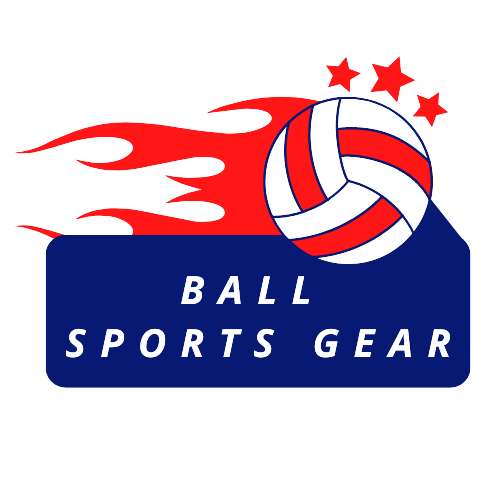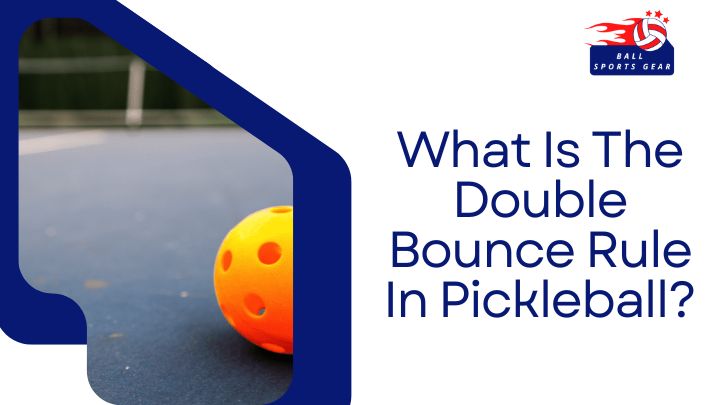Pickleball has been around for decades and is rapidly growing in popularity. It can be played by anyone, regardless of age or skill level. The game differs significantly from other sports like tennis and table tennis in its rules: the double bounce rule pickleball!
Pickleball is a simple game, but it has some rules that can confuse beginners. It looks like the pickleball double bounce rule is one of those rules. What is the double bounce rule in pickleball? It’s also called the two-bounce rule, which makes it a lot more confusing at first. This is one of the important rules that are considered mandatory in the game, the name itself explains the rule a little, which means two rebounds.
Pickleball’s double bounce rule affects the serve, return, and pitch after the return. The rule is simple, but it works to make Pickleball a delightful rally game rather than a quick and choppy scoring game. Understanding the double bounce rule is essential to a good game of pickleball.
The Double Bounce Rule Pickleball Explained
What is the double bounce rule in pickleball? The purpose of the Double Bounce rule is to provide a smooth transition into the Eat and Rally phase of the game. Note that this double bounce rule pickleball does not mean that the first 2 shots in pickleball have to bounce. As you know, you lose a point if you bounce the ball twice on your side. As a result of this rule, the ball must bounce once on both sides of the serve and return. Dribbling must be done from both sides of the court, which is why it is called the double dribble rule.
What is the two shot rule in pickleball? The double bounce rule or the two bounce rule states: “Each team must play its first shot and bounce the ball first. Whoever serves or returns the serve without the ball bouncing twice will be penalized. However, players may do the volley after the first two shots and hit the ball if it goes up.”
Implication
First, this rule refers to the next two shots after serving the ball for a point. This forces teams in the game to take the first shot to bounce off the ground. The receiving team must allow their ball to touch the ground and the serving team must also allow the return to bounce before they can hit it.
If the ball hits one side of a net, it may bounce twice more and then be cleared. If you still don’t understand the rule, here are some helpful steps to help you understand it more clearly:
- A player transfers his ball to the other side
- The receiving team must bounce the ball before returning it.
- The serving team must still bounce the ball before returning.
- Once the ball bounces back and forth, all players can hit the ground or volley until they score.
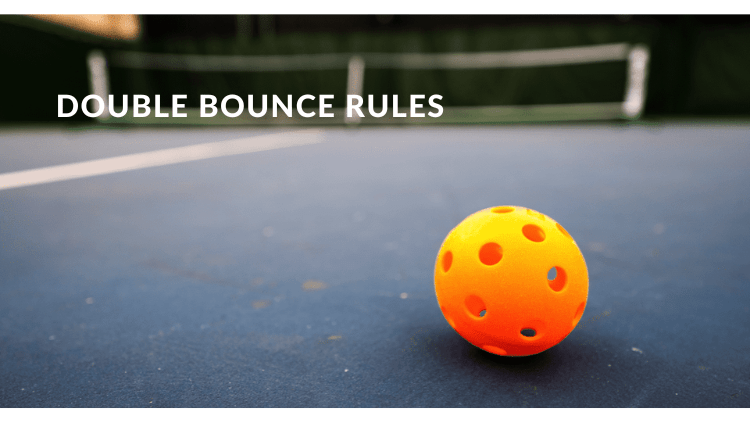
Purpose of Double Bounce Rules
Pickleball was built around rallying to make the game more fun for everyone. This wouldn’t be possible without the double jump rule.
The double jump rule in Pickleball was intended to level the playing field and remove the skewed advantage to the serving team. The double jump rule exists to make the game truly playable. Without this rule, the game would be very frustrating. Let’s understand in detail what does the double bounce rule mean in pickleball:
- The rule is designed to allow the game to progress naturally without giving an undue additional advantage.
- Pickleball is a game of skill and strategy with an emphasis on doubles. This rule allows everyone to enjoy the experience, not just those who can make quick moves to base point or aerial shots!
- The best players can take any return of serve or weak hit on the line and make it easy. The point would end in two strokes if the serves were executed spontaneously (in the case of no rebound).
- It becomes a tedious game when the point is only 2-3 moves.
- Weak services and noisy servers will be difficult to deal with as they bounce before coming back.
A ball dunked over the net can also cause problems for the opposing team as they have to move away from the baseline while trying not to miss an easy volley return! Therefore, the pickleball must bounce before returning.
While this rule might seem like an unfair way to eliminate the serve and volley advantage, it actually makes playing longer rallies easier. The game will have a smooth transition thanks to this new rulebook. This gives each team more time to strategize without being able to immediately take control of the points, as well as space in the opposing half with shots shorter than the cross.
The Pickleball Double-Bounce Rule: How Does It Benefit You?
The serving team must bounce the ball before hitting it a second time. So that single hit effectively slows them down before they can even think about reloading the web.
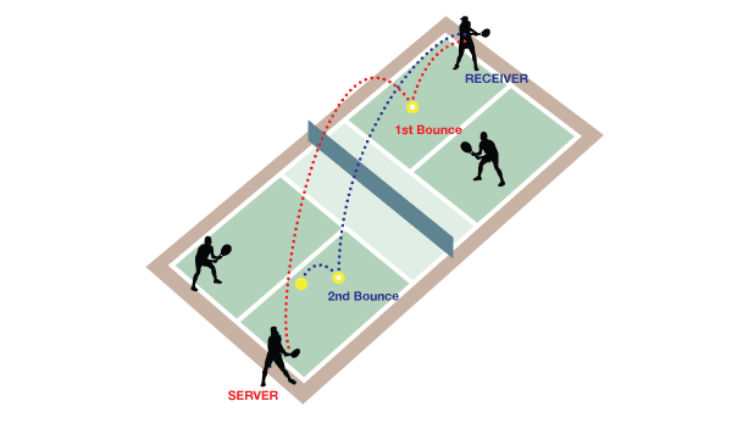
It makes the game fun and playable for all skill levels and boosts the score. Because it is also unique, many fans argue and appreciate that this is why the game is exciting enough to make it to the Olympics.
As we know, in pickleball, the serving team gets points. However, the double jump rule helps the returning team in the same way. Immediately after the return of the service, they have enough time to hit the ball with a powerful volley. As a result, the service side (if it hasn’t reached the kitchen yet) makes a mistake, and then the return staff is served.
- It also extends rallies. Without the double-jump rule, the game would be over quickly once you started the volleys. Also, risking a volley early in the game causes players to lose momentum, so the double dribble rule saves them by allowing them to stay grounded before they start to break down.
- This rule deprives the tennis player of the great advantage that legends like Pete Sampras or John McEnroe used.
- This rule could really change the way people approach pickleball and play it at a professional level. Instead of skipping the first round and taking your opponent down, the game starts slow and gradually builds up in intensity.
The Rule: Tips for Beginners
Well, it is common for a beginner to forget the double jump rule and hit the ball as soon as it lands on his seat. Impatience and tennis experience are basically the reasons why you cannot follow the double jump rule. Don’t worry, we’ll take care of you!
The best way to remember the rule is to stand well away from the court when returning a serve. Consciously try to take a few steps back to remind yourself to bounce the ball. Use the baseline as a visual guide to know where to stop. The same advice applies on the service side. Allow yourself to step back to make way for the third movement. It also works really well when the ball lands close to the baseline because you give yourself room to bounce instead of reacting too quickly and completely.
Another mistake you see all the time is when someone on the serving side moves quickly after the serve has been made. If you’re a seasoned player, you’re probably shaking your head reading this. We’ve all seen and done it. I know I have! It is common for beginners to start moving toward the net after a serve, but this is a mistake. If the jump is deep and coming towards you, it will likely land close to your feet and be hard to hit when it bounces. So remember, stay back!
Even after the service, it’s wise to hold back. Don’t go forward because you don’t know how fast the ball will come. However, once the opponent has landed everything, identify the timing and then position yourself in or near the no-volley zone, depending on that.
Who Invented the Pickleball Double Bounce Rule?
There is a fascinating story behind the origins of Pickleball that needs to be told. There are two fathers who invented Pickleball in 1965: Joe Pritchard and Bill Bell, the founding fathers of the game, which was invented in Seattle, on Bainbridge Island, as parents usually do, and decided to give their children pleasure in the summer. To entertain their children during the summer months, they set up a badminton-sized court in their backyard, where they practiced the sport with racquets.
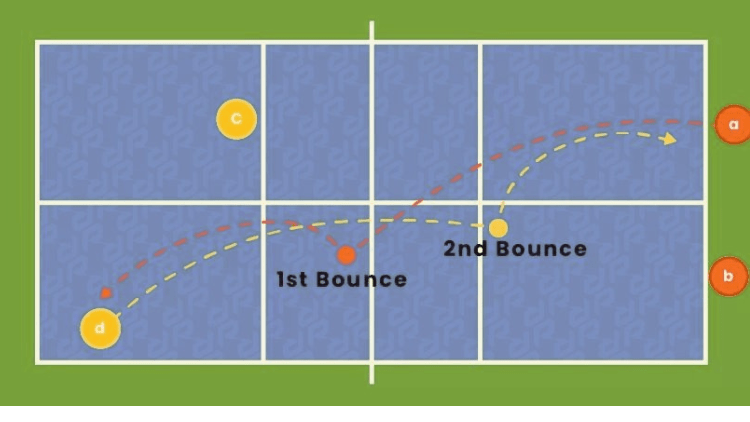
While we know how the game started and the pickleball rules were created by these two parents to ensure the game is fair for all family members, we don’t know the details of the double jump rule that was created. While we’ll never know how this happened, it was likely part of the game’s original rules when it was created.
Frequently Asked Questions
Is pickleball the only sport with the double jump rule?
It’s a rule that makes the sport of pickleball unique. It is the only padel game (under the general padel/racket umbrella) that requires the double jump rule, making rallies fun and competitive.
Can the ball bounce twice under the two-bounce rule?
Ideally, Pickleball can only bounce once on the court. In fact, the two-bounce rule applies to serving and returning serve. Thus, the ball bounces twice, but once on each side of the net.
Are the “two-hop rule” and the “two-hop rule” the same?
The answer is yes. The double jump rule was introduced in 2018 and is now officially called that. However, what does this mean? You still have to hit the ball twice before putting it into play (volley). If a contestant lands his shot once without bouncing, he will be disqualified from the competition.
Conclusion
Pickleball aims to attract more people with its relaxing and fun style. So if it’s over in less than five minutes, how can we enjoy it? The double jump rule creates more moves and lengthens the game, making it more interesting.
The double jump is a classic rule that sets pickleball apart from other tennis sports. The rule is to bounce the ball twice before initiating the volley. The rule played a crucial role in making Pickleball fun and easy, and so far, it also keeps the integrity of the game alive.
